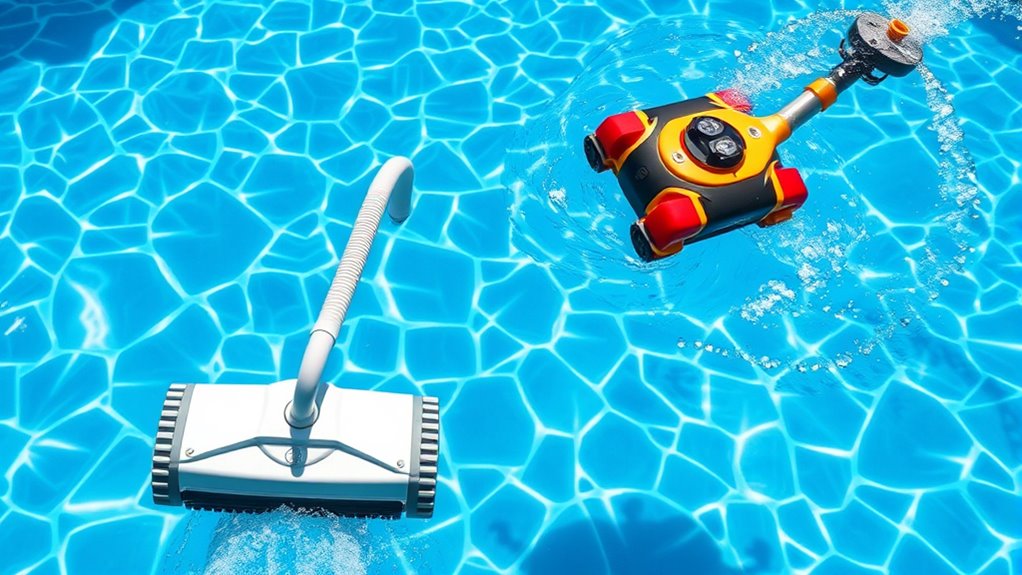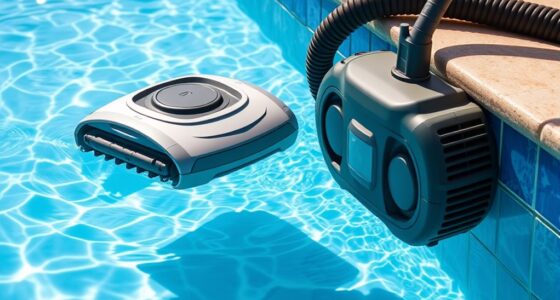Suction pool cleaners work using your pool’s filtration system, pulling debris into filters, and are great for small particles and flat surfaces, while pressure cleaners use a booster pump to push water through onboard turbines, handling tougher debris and complex shapes. Installation varies, with suction models connecting directly to skimmers and pressure ones needing a dedicated pump. Understanding their mechanisms, performance, and maintenance can help you choose the right cleaner—if you want to explore more, stay tuned.
Key Takeaways
- Suction cleaners use the pool’s filtration system for power, while pressure cleaners require a booster pump for high-pressure water.
- Suction cleaners excel at capturing small debris and work best in shallow, flat areas; pressure cleaners handle complex surfaces and obstacles.
- Suction models generally cost less and consume less energy but may need more frequent filter maintenance.
- Pressure cleaners are more effective on irregular shapes and tight corners but tend to be pricier and more energy-intensive.
- Proper installation, filter maintenance, and compatibility influence the efficiency and lifespan of both cleaner types.
How They Operate: Suction vs. Pressure Mechanisms
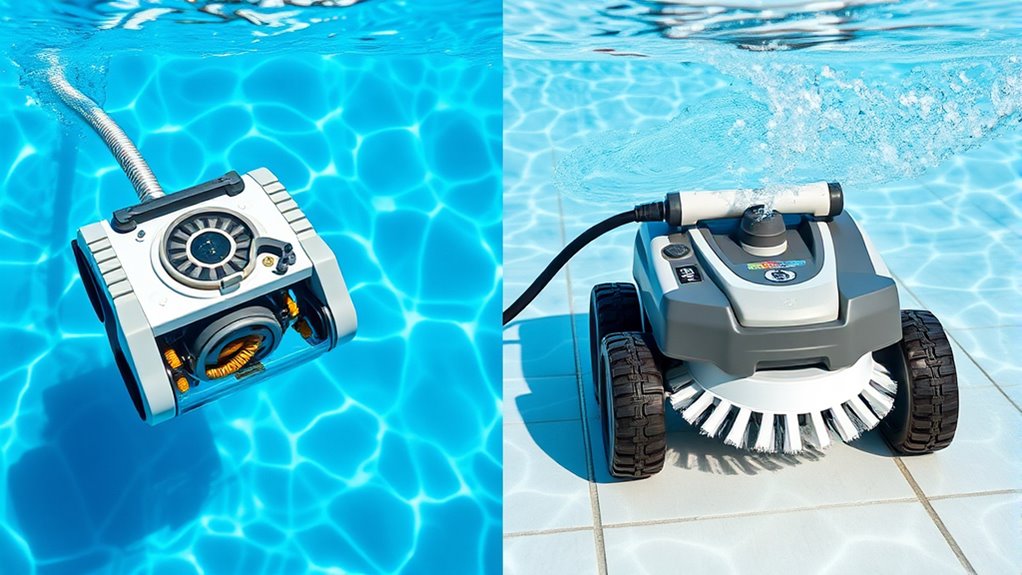
Suction and pressure pool cleaners operate using different mechanisms to remove debris from your pool. Suction cleaners rely on the power source of your pool’s filtration system to create suction, pulling debris into their filtering mechanisms. They connect directly to your skimmer or dedicated suction line, using the pump’s suction to vacuum dirt and leaves from the pool floor. Pressure cleaners, on the other hand, use a separate power source, typically a booster pump, to generate high-pressure water. This pressurized water drives a turbine inside the cleaner, moving it around the pool while pushing debris into an onboard filter. Both types depend on distinct filtering mechanisms to trap debris, but their power sources and operational methods set them apart considerably.
Installation and Setup Processes
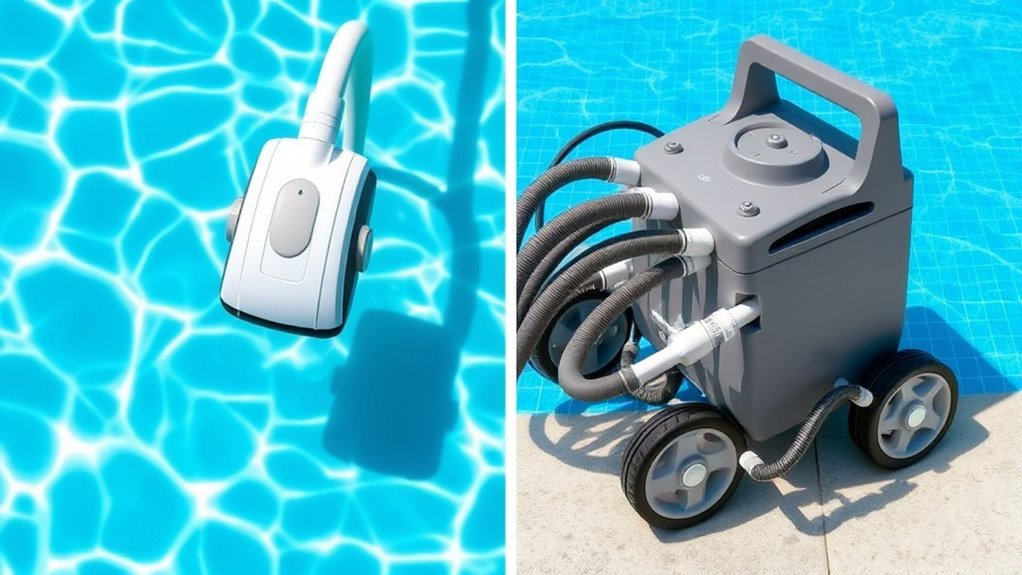
Setting up your pool cleaner properly guarantees it operates efficiently and lasts longer. Begin by attaching the hose and ensuring the cleaner’s filter and brushes are clean. For suction cleaners, connect the hose securely to the skimmer or dedicated port, making sure it’s free of kinks to maintain ideal suction. Pressure cleaners often require a dedicated booster pump, so check that it’s working correctly before setup. Consider pool toy compatibility when choosing your cleaner; some models might interfere with toys or accessories. Aesthetic design options come into play if you want a cleaner that blends seamlessly with your pool’s look. Take your time during installation to prevent leaks or misalignments, which can impair performance and reduce the cleaner’s lifespan.
Cleaning Performance and Coverage

The effectiveness of your pool cleaner largely depends on how well it covers the entire pool surface and removes debris. Suction cleaners excel in filtration efficiency, capturing small particles and fine dirt effectively. Conversely, pressure cleaners often showcase superior surface adaptability, handling various pool shapes and debris types. To compare performance:
- Suction cleaners provide consistent coverage in shallow and flat areas, making them ideal for straightforward pool designs.
- Pressure cleaners navigate complex surfaces and tight corners more easily, especially in pools with intricate features.
- Filtration efficiency is higher in suction models, trapping smaller debris, which contributes to cleaner water quality.
- Surface adaptability makes pressure cleaners ideal for irregular pools or those with obstacles.
- The size and shape of the pool also influence which type of cleaner performs best. Additionally, the type of debris commonly found in your pool can determine which cleaner is more effective for your needs.
- Understanding the tuning capabilities of Honda models can assist in maintaining optimal pool equipment performance and longevity. Incorporating proper maintenance and understanding performance tuning principles can further enhance the longevity and efficiency of your pool cleaning equipment.
Ultimately, your choice impacts how thoroughly your pool is cleaned, with each type excelling in different coverage scenarios.
Maintenance and Durability Factors
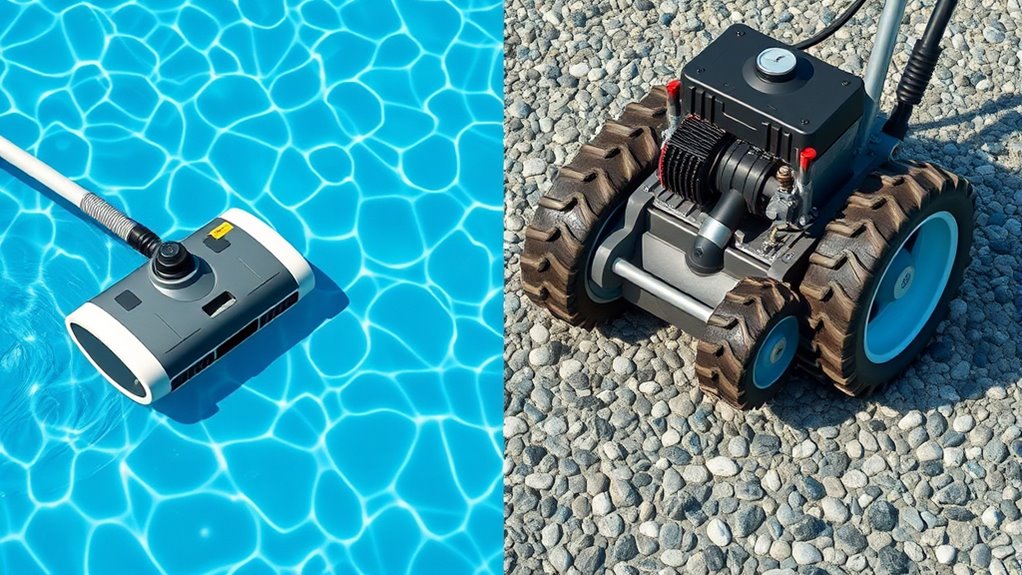
Maintaining your pool cleaner and ensuring its durability depends on regular upkeep and understanding its design. Start by inspecting and cleaning filter types regularly; different cleaners use skimmer baskets, cartridge filters, or bag filters. Clean or replace these filters as needed to prevent clogs and maintain ideal suction or pressure. Pay attention to material durability—choose models made from corrosion-resistant plastics or sturdy components that withstand exposure to chemicals and constant use. Rinsing your cleaner after each use helps remove debris and prevent buildup that can cause wear. Additionally, understanding the performance metrics of your cleaner can help you identify when maintenance is needed, ensuring optimal operation. Regularly monitoring for sensor malfunctions can prevent improper functioning and extend the lifespan of your device. Proper maintenance not only extends your cleaner’s lifespan but also helps prevent corrosion and material degradation, keeping it performing efficiently, saving you time and money in the long run. The use of advanced materials in construction further enhances the durability and longevity of modern pool cleaners.
Cost Considerations and Energy Efficiency
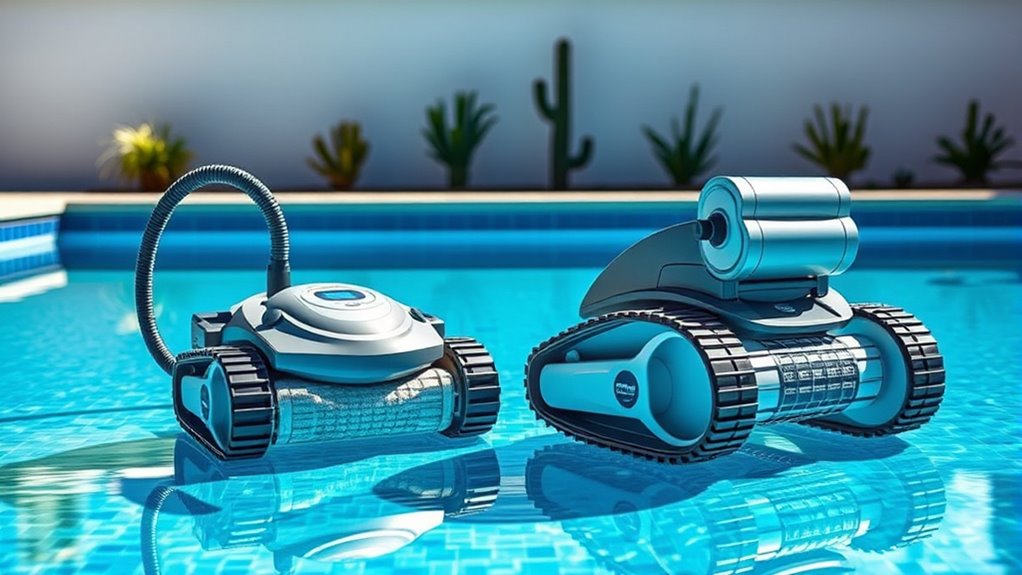
Choosing a pool cleaner that balances cost and energy use can save you money over time. When comparing suction and pressure cleaners, consider these factors:
- Pricing disparities: Pressure cleaners often cost more upfront but may reduce long-term maintenance expenses.
- Energy consumption: Pressure models typically use more power, increasing your energy bills.
- Operating costs: Suction cleaners generally have lower energy needs but may require more frequent maintenance.
- Efficiency over time: Evaluate how much energy each type consumes during cleaning cycles to determine which is more cost-effective.
Frequently Asked Questions
Which Type Is Better for Uneven Pool Surfaces?
For uneven pool surfaces, pressure pool cleaners often perform better because they adapt to various textures, providing consistent cleaning efficiency. Suction cleaners might struggle with complex surface textures, leaving debris behind. You’ll find that pressure models can navigate irregularities more easily, ensuring thorough cleaning. So, if your pool has a rough or uneven surface, a pressure pool cleaner is likely the better choice for maintaining a clean, debris-free pool.
Can Suction or Pressure Cleaners Handle Large Debris Effectively?
They say “big things come in small packages,” but when it comes to pool cleaners handling large debris, size matters. Suction cleaners usually have limited debris capacity, which can reduce cleaning efficiency with big debris. Pressure cleaners often handle larger debris more effectively due to their higher debris capacity, making them better for cleaning efficiency when large debris is involved. Choose the right type based on your debris size and cleaning needs.
Are There Specific Pool Shapes That Suit One Cleaner Type Over the Other?
You might find that certain pool shapes influence which cleaner works best for you. For example, irregular or freeform pools often favor pressure cleaners because they navigate curves more easily. In contrast, suction cleaners tend to suit rectangular or simple shapes, offering straightforward cleaner installation ease. Consider your pool’s shape and how easily you can access all areas to choose the right type, ensuring efficient cleaning and hassle-free maintenance.
How Do Suction and Pressure Cleaners Perform in Saltwater Pools?
In saltwater pools, both suction and pressure cleaners perform well, but you should watch for saltwater effects. Salt can accelerate corrosion concerns, especially on metal parts. Suction cleaners tend to be more resistant because they have fewer moving parts exposed to salt, while pressure cleaners’ hoses and fittings might need extra maintenance. Regularly inspect your cleaner and rinse it after use to prolong its life and prevent corrosion.
What Safety Considerations Are Associated With Each Cleaner Type?
When considering hazard risks and safety precautions, both suction and pressure pool cleaners require careful handling. You should guarantee the power supply is unplugged before maintenance to prevent electrical hazards. Keep debris away from suction intakes to avoid clogging, and check hoses for leaks to prevent water damage. Always read the manufacturer’s safety instructions, wear protective gear if needed, and supervise the cleaner during operation to minimize risks.
Conclusion
Choosing between suction and pressure pool cleaners is like picking the right tool for a job—you want efficiency and reliability. I once watched a friend’s pressure cleaner glide effortlessly across her pool, covering every inch like a diligent worker. Remember, understanding their differences helps you make an informed decision, ensuring your pool stays pristine without breaking the bank. So, weigh your needs carefully—your perfect pool cleaner is out there, ready to make your pool sparkle effortlessly.
